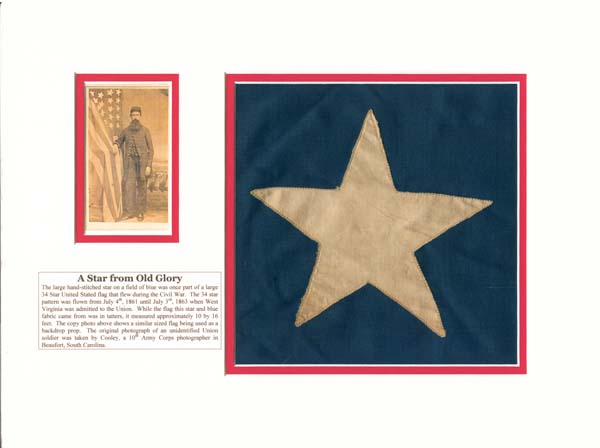A Star from Old Glory Flag Relic
Inv# AM1108
The prominent hand-stitched star set against a blue background was once part of a 34-star United States flag that was displayed during the Civil War. This particular flag design was in use from July 4, 1861, until July 3, 1863, coinciding with West Virginia's admission to the Union. Although the flag from which this star and blue fabric originated is now in a state of disrepair, it originally measured approximately 10 by 16 feet. The accompanying photograph illustrates a similarly sized flag utilized as a backdrop. The original image features an unidentified Union soldier and was captured by Cooley, a photographer from the 10th Army Corps, in Beaufort, South Carolina. Due to deterioration in the red and white stripes, the stars of this flag have become a significant artifact. These large barracks flags were typically displayed on public buildings, in camps, and within troop barracks. This particular star hails from the West Virginia region and remains attached to its original blue fabric, with a photograph of the same damaged flag included at the back. Each of the 34 stars is individually numbered. The 34-star flag was officially in use from July 4, 1861, until July 3, 1863.
The flag of the United States, commonly known as the American flag or U.S. flag, serves as the national emblem of the country. It features thirteen equal horizontal stripes, alternating between red and white, with a blue rectangle in the upper left corner, known as the "union," which contains fifty small, white, five-pointed stars arranged in nine offset horizontal rows. The arrangement consists of rows with six stars at the top and bottom, alternating with rows of five stars. The fifty stars symbolize the fifty states of the United States, while the thirteen stripes represent the original thirteen British colonies that declared their independence from Great Britain, thus becoming the first states of the U.S. The flag is also referred to by several nicknames, including the Stars and Stripes, Old Glory, and the Star-Spangled Banner. Before the Civil War, the American flag was seldom displayed outside military installations, government offices, and naval vessels.
During the American Revolutionary War and the War of 1812, the army was not officially permitted to carry the flag into combat. It was not until 1834 that artillery units were authorized to bear the American flag, with the army receiving similar permission in 1841. However, in 1847, during the conflict with Mexico, the flag was restricted to use within encampments and was not allowed in battle. This situation changed dramatically after the events at Fort Sumter in 1861. The flag that had been hoisted over the fort was permitted to accompany Union troops as they surrendered. It was subsequently transported through northern cities, igniting a fervor known as "Flagmania." The stars and stripes, which had previously lacked significant public recognition, rapidly became integral to the national identity. The flag emerged as a powerful symbol of the Union, leading to a surge in flag sales. In a significant shift, the regulations from 1847 were rescinded, allowing the flag to be carried into battle. Although some advocated for the removal of the stars representing the seceded southern states, President Abraham Lincoln opposed this idea, believing it would confer legitimacy to the confederate states.










Ebay ID: labarre_galleries